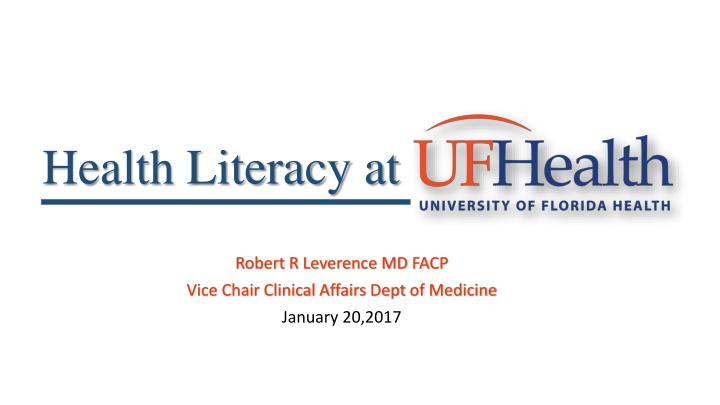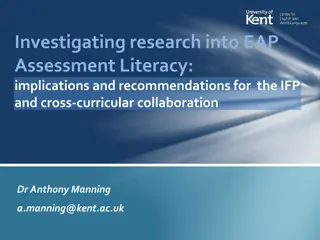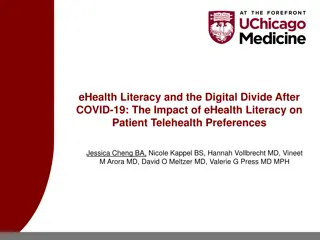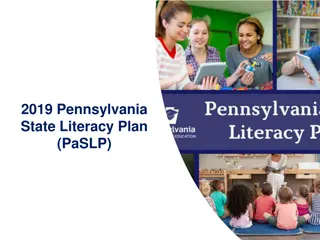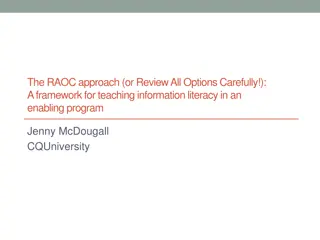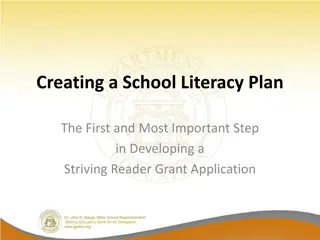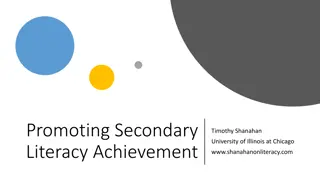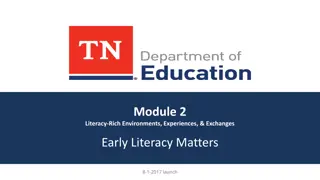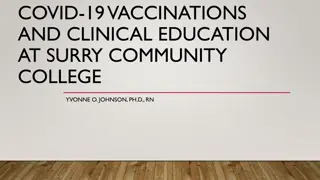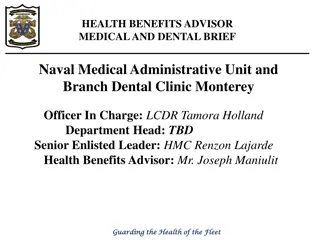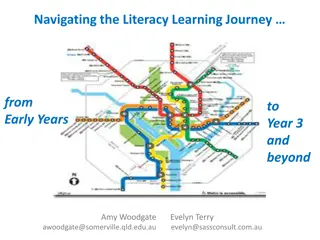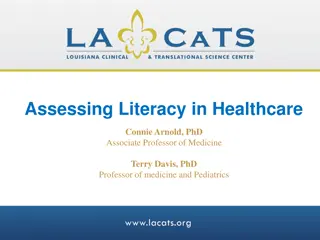Implementation of Routine Health Literacy Assessment in Academic Medical Center
Implementation of routine health literacy assessment at an academic medical center involved a hospital-wide assessment by nurses applied to adult inpatients, with results documented in electronic health records and care plans generated for positive screenings. The process showed good ease of use, patient acceptance, and 84% patient screening rate after six months. The study concludes that routine health literacy assessment can be successfully integrated into nursing workflow and electronic health records in a major academic medical center.
Download Presentation

Please find below an Image/Link to download the presentation.
The content on the website is provided AS IS for your information and personal use only. It may not be sold, licensed, or shared on other websites without obtaining consent from the author.If you encounter any issues during the download, it is possible that the publisher has removed the file from their server.
You are allowed to download the files provided on this website for personal or commercial use, subject to the condition that they are used lawfully. All files are the property of their respective owners.
The content on the website is provided AS IS for your information and personal use only. It may not be sold, licensed, or shared on other websites without obtaining consent from the author.
E N D
Presentation Transcript
Health Literacy at Robert R Leverence MD FACP Vice Chair Clinical Affairs Dept of Medicine January 20,2017
With campuses in Gainesville and Jacksonville, UF Health includes six health colleges, nine research institutes and centers, two teaching hospitals, two specialty hospitals and a host of physician medical practices and outpatient services throughout north central and northeast Florida. Our mission is to promote health through outstanding and high-quality patient care; innovative and rigorous education in the health professions and biomedical sciences; and high-impact research across the spectrum of basic, translational and clinical investigation.
Outline Outline Implementation of a Routine Health Literacy Assessment at an Academic Medical Center. A Descriptive, Multi-method Study. PI: Robert Leverence MD Implementation of a Health Literacy Assessment in Perioperative Coordinated Care. PI: Nila Radhkrishna Advance Directives Completion Rates and an Intervention to Address Health Literacy in a Clinic Population. PI: Melanie Hagen MD
Implementation of a Routine Health Literacy Implementation of a Routine Health Literacy Assessment at an Assessment at an Academic Medical Center Academic Medical Center. . A Descriptive, Multi A Descriptive, Multi- -method Study method Study A hospital-wide brief health literacy assessment was initiated by nurses in April 2014 and applied to all adult inpatients. Results were documented in the electronic health record, which then generated care plans and alerts for patients who screened positive. A nursing survey showed good ease of use and adequate patient acceptance of the screening process. Six months after hospital-wide implementation, retrospective chart abstraction of 1455 patients showed 84% were screened. We conclude that a routine health literacy assessment can be feasibly and successfully implemented into the nursing workflow and electronic health record of a major academic medical center. Methods Results Conclusion
Rapid Estimate of Adult Literacy in Medicine-Short Form (REALM-SF)
REALM-SF: Instructions for Administration 1. Give the patient a copy of the Rapid Estimate of Adult Literacy in Medicine- Short Form and explain reason for the procedure to patient: We as a team want to make sure that we provide the best education to our patients. Please read as many words as you can from this list. Begin with the first word and read out loud. When you come to a word you cannot read, just skip it and go on to the next word. 2. If patient is apprehensive or resists doing the screen, you can respond as follows: We want to be sure that we are communicating to you in a way you can understand. Like when I take my car to get repaired, they may say crank shaft gasket, and I don t understand it. In hospitals, we use words that many people find confusing. We want to make sure that we communicate in the best way for you. 3. Scoring: If patient takes more than 5 seconds on a word, coach them to proceed to the next word. If patient begins to miss every word, have him or her speak only known words. 4. Count how many words the patient was able to speak correctly.
REALM-SF: Instructions for Administration 1. Give the patient a copy of the Rapid Estimate of Adult Literacy in Medicine- Short Form and explain reason for the procedure to patient: We as a team want to make sure that we provide the best education to our patients. Please read as many words as you can from this list. Begin with the first word and read out loud. When you come to a word you cannot read, just skip it and go on to the next word. 2. If patient is apprehensive or resists doing the screen, you can respond as follows: understand it. In hospitals, we use words that many people find confusing. We want to make sure that we communicate in the best way for you. We want to be sure that we are communicating to you in a way you can understand. Like when I take my car to get repaired, they may say crank shaft gasket, and I don t We want to be sure that we are communicating to you in a way you can understand. Like when I take my car to get repaired, they may say crank shaft gasket, and I don t understand it. In hospitals, we use words that many people find confusing. We want to make sure that we communicate in the best way for you. 3. Scoring: If patient takes more than 5 seconds on a word, coach them to proceed to the next word. If patient begins to miss every word, have him or her speak only known words. 4. Count how many words the patient was able to speak correctly.
Health Literacy - REALM-SF Compliance and Prevalence Data Patients Admitted September 23 October 20, 2014 Prevalence of Health Literacy Levels # Unable to Assess Complianc e With Use of Tool # Screene d # % # % % Unable to Assess # Unit Admitte d Screene d Adequat e Adequat e % Limited Limited General Medicine, South Wing General Medicine, East Wing General Medicine Teaching Family Medicine Cardiology Surgery Labor and Delivery Orthopaedics Urology 149 129 107 12 10 83% 8% 87% 9% 141 131 105 18 8 80% 6% 93% 14% 175 224 149 159 201 132 125 143 202 137 97 189 110 82 91 137 112 86 179 98 72 46 53 25 9 10 8 10 6 64% 68% 82% 89% 95% 89% 88% 4% 6% 0% 2% 0% 4% 0% 82% 90% 92% 61% 94% 83% 66% 32% 26% 18% 9% 5% 7% 12% 12 0 2 0 4 0 16% (95% CI, 13- 18%) 1455 1220 987 191 42 81% 3% TOTAL 84%
Implementation of a Routine Health Literacy Implementation of a Routine Health Literacy Assessment at an Assessment at an Academic Medical Center Academic Medical Center. . A Descriptive, Multi A Descriptive, Multi- -method Study method Study Next Steps? For inpatients with limited health literacy, pharmacy tech to review all meds at discharge. Currently being piloted.
Implementation of a Health Literacy Assessment in Implementation of a Health Literacy Assessment in Perioperative Coordinated Care Perioperative Coordinated Care We used the REALM-SF to screen patients in the presurgical clinic. Results were recorded in the patient s electronic health records. A total of 9597 patients was seen at the presurgical center over a period of 9 months; 6659 patients (69%) were screened for health literacy. Fifteen percent (15%) of patients was found to have limited health literacy. Health literacy screening tools can be easily implemented in a preoperative setting and used to establish perioperative care plans based on a patient s health literacy level. Methods Results Conclusion
Next Steps 2. Associate Health Literacy with: OR cancellations Hospital LOS ICU admissions/ventilator days readmissions 3. Then provide interventions to mitigate effects of LHL: Teach back Have family member present Navigator??
Advance Directives Completion Rates and an Advance Directives Completion Rates and an Intervention to Address Health Literacy in a Intervention to Address Health Literacy in a Clinic Population Clinic Population The aim of this study is to enhance completion rates of advance directives by taking into consideration a patient s health literacy level. Specifically we plan to assess the impact of an ambulatory intervention on the completion rate of advance directives for patients with adequate and limited health literacy. Our hypothesis is that both groups (adequate and limited health literacy) will benefit from the intervention, but patients with limited health literacy will show a greater improvement in the advanced directives completion rate. This is relevant in regard to directing clinic resources. Aim Hypothesis
Advance Directives Completion Rates and an Advance Directives Completion Rates and an Intervention to Address Health Literacy in a Intervention to Address Health Literacy in a Clinic Population Clinic Population Primary outcome measures: Documentation of completed patient advanced directives in Epic Patient satisfaction based on a brief satisfaction survey at the end of the clinic visit. Outcome measures Funding Funded by an Intramural Grant from UF Health Self Insurance Program
Advance Directives Completion Rates and an Advance Directives Completion Rates and an Intervention to Address Health Literacy in a Intervention to Address Health Literacy in a Clinic Population Clinic Population A randomized control trial. Clinic physicians identify potential patients. Eligibility includes English speaking, intact cognitive function, age over 50 years, and no advance directive in EPIC. Subjects are referred to a research assistant in clinic who is tasked with assessing eligibility criteria and obtaining consent. The RA is responsible for randomizing patients to the intervention or the control group. The RA conducts REALM-SF screening for health literacy, provides a copy of the UF Health Advanced Directives brochure, and afterward verbally administer the patient satisfaction questionnaire. Methods
Advance Directives Completion Rates and an Advance Directives Completion Rates and an Intervention to Address Health Literacy in a Intervention to Address Health Literacy in a Clinic Population Clinic Population Additionally, for the intervention group only, the RA reviews and walks through the 9 page Advanced Directives brochure and answers any questions. This will take 3-5 additional minutes. The control patients will merely be handed the Advanced Directives manual with brief encouragement to complete and return it.
Advance Directives Completion Rates and an Intervention to Address Health Literacy in a Clinic Population Intervention Control Adequate health literacy, receive intervention on advance directives Adequate health literacy control group Adequate Literacy Limited health literacy, receives intervention on advance directives Limited health literacy control group Limited Literacy
Advance Directives Completion Rates and an Advance Directives Completion Rates and an Intervention to Address Health Literacy in a Intervention to Address Health Literacy in a Clinic Population Clinic Population Results?
Health Literacy at Robert R Leverence MD FACP Vice Chair Clinical Affairs Dept of Medicine January 20,2017
